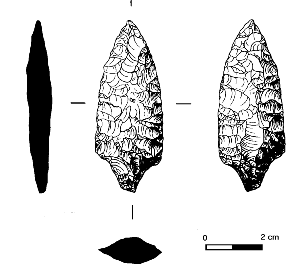THE LITHICS
by James Conolly
 (left) Figure 20: Obsidian projectile point 2165.X1
(left) Figure 20: Obsidian projectile point 2165.X1
In marked contrast to previous seasons, 1997 produced a large volume of knapped stone. Of these 1172 flint and obsidian artefacts were recorded from dry-sieve samples, plus a further 716 from wet-sieved or floated samples of 4mm fraction. As in previous years, the vast majority of this material was obsidian, with only a few flint artefacts found.
The range of debitage and tools recovered this season was comparable to previous years. Blades and flakes, plus several cores, shatter, and small chips were collected, as was a range of retouched debitage. This season's assemblage of tools once again shows the enormous variety of forms retouched obsidian and flint may occur. A variety of small irregularly retouched flakes, large well-shaped flakes, blades with irregular retouched to blades with fine distal shaping, pièces esquillées, a typologically diverse array of projectiles on both blades and flakes, plus a remarkable flint dagger with a bone hilt (fig 14) were amassed from the excavations in the Mellaart, Bach, and North areas.
The 1997 season also dramatically increased the number of large obsidian flakes found within caches. One cache of 50 large, heavy, flakes found in Space 113 (fig 12) are at the same time contextually circumscribed and technologically distinct. The total weight of all obsidian in the cache was 2309.07 grams (which included 16 small flakes and chips of <1 gram each), whereas the mean weight of the main body of flakes was 47.02 grams. The mean length of the cached flakes is 77mm, width 54mm, and thickness 14mm. Four of the cache also had evidence of residual cortical surfaces. Most were missing their proximal ends, so details concerning their method of reduction were difficult to deduce. However, the 10 pieces that do retain evidence of detachment show very high platform angles, flat to facetted striking platform remnants, and a mix of diffuse to very prominent bulbs of percussion and in sum suggest a direct hard-hammer approach to removal. The range of morphology of the flakes - from thin and elongated to thick and fat examples - are suggestive of a relatively non-structured and opportunistic removal strategy where the objective was to obtain only a relatively large flake that could be further used for whatever its particular shape was suited for. Indeed, the type of retouch on the flakes shows a lack of desire to significantly change edge morphology through retouch, but to instead use the pre-existing profile as the basis for a working edge.
As with several of the other caches of large obsidian artefacts (such as the flakes in 1993, and blades in 1996, as well as Mellaart's numerous examples) there is no evidence for any cores suitable for manufacturing flakes of this kind within the known assemblage. It would seem increasingly probable that this type of deposit, given their technological idiosyncrasies, are pre-formed imports from the obsidian sources in Central Anatolia brought to Çatalhöyük and, without significant modifications to their original state, cached.